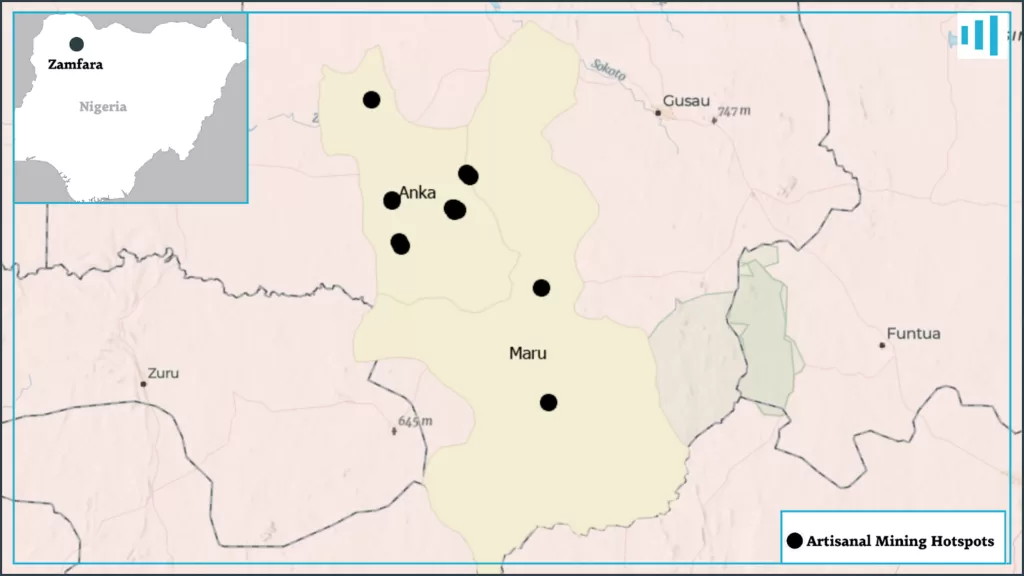Abdulwahab Salisu walked through a murky puddle; each footfall stuck firmly into the slippery soil. He stretched the dirt pan he held towards his fellow, who was already knee-deep in sludge, hacking out the muddy earth. It was a Saturday morning in October 2024. Salisu took the dirt-filled pan back to the puddle and began sieving it. His hands moved with a certain ease that comes from years of practice as water swirled brown and thick around his wrist.
At 15, Salisu is an old hand at tracing specks of gold. His fingers were still moving when his eyes caught a glimmer in the pan. He paused and rinsed the specks into a small steel bowl before returning to the pit.
Salisu’s daily routine is to wake up every morning for prayers, take his breakfast and head straight to the mining site in the Kabai area of Maru, a town in the northwestern Zamfara state. With other children from his village and nearby communities, he toils hard to dig for precious stones till later in the evening, when he attends an Islamic school. Salisu makes himself available during school hours at the local junior secondary school, but his mind often wanders through the mine in the passing hours.
“I earn between ₦3,000 and ₦4,000 from now until dawn,” he told HumAngle. “My earnings vary – there are times I make that amount or even less. It’s possible to earn more, depending on how hard I work.” He leaves earlier than his classmates at school to meet his daily quota at the mining site. The paycheck makes it worthwhile, he said.
At his young age, Salisu has carved pieces of himself — some little scars here and healing wounds there — to carry the weight of the pain buried within the earth. There’s one he sustained recently. He had just returned from school on a Friday, taking off his uniform and heading straight to the mining site. He had an unusual feeling about the day. But it wasn’t enough to keep him away from the site. He was in a shallow well dug along the waterway, shovelling the earth into the pan, when he felt a sudden, sharp pain in his leg. He didn’t think much of it until he doubled over to see blood gushing out of his right toe. He said he was lucky.
“Mining gold can be very dangerous,” Salisu said. “The tunnel could collapse and fall on anyone or bury them alive. Sometimes, when these accidents happen, they can be fatal — a person could suffer fractures, injuries, cuts, or wounds. So, the cut that day couldn’t even stop me from going for more.” His cut was caused by a shovel he was using to dig.
Zamfara State harbours large deposits of untapped solid minerals like gold, most mined illegally. Some of the boys dig wells and work underground with torches strapped to their foreheads. Some are charged with pulling heavy bags of earth under the town’s relentless sun, while others simply rinse them in the flowing river or nearby puddles.
“Despite everything that happened, I got my highest sales that day. I earned about ₦15,000 from the gold I mined. Yes, I suffered a lot, but I was very happy,” he said, unbothered that the cut is yet to heal.
Salisu gives his earnings to his parents to take care of the family’s expenses. He also saves some to buy things for himself, like the baseball cap and shorts he wore. “I wanted to help my parents with enough money for food. My parents are farmers, and because of “barayi” (the local Hausa word for thieves), they’re not able to go to the farm and get money as they used to.”
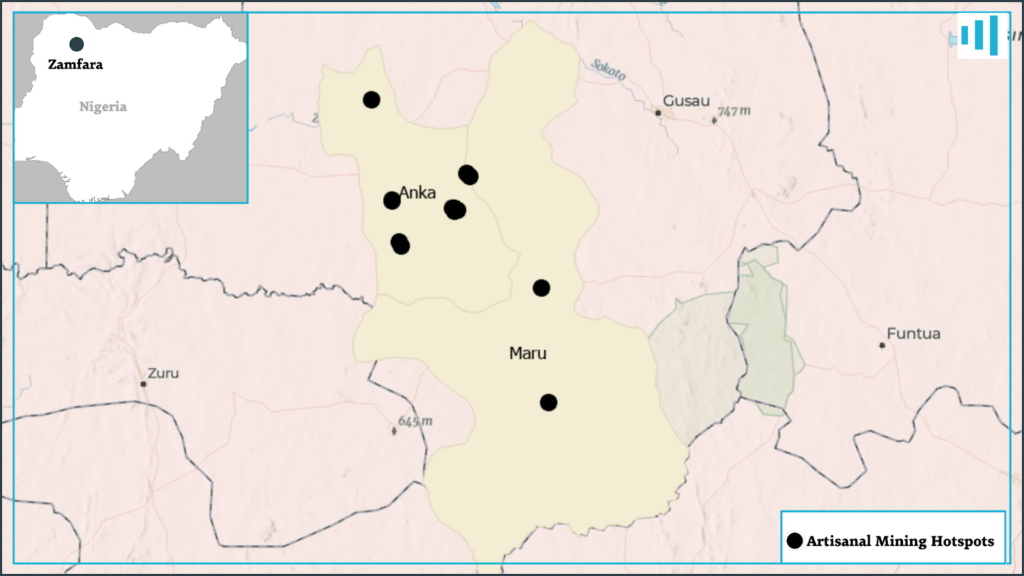
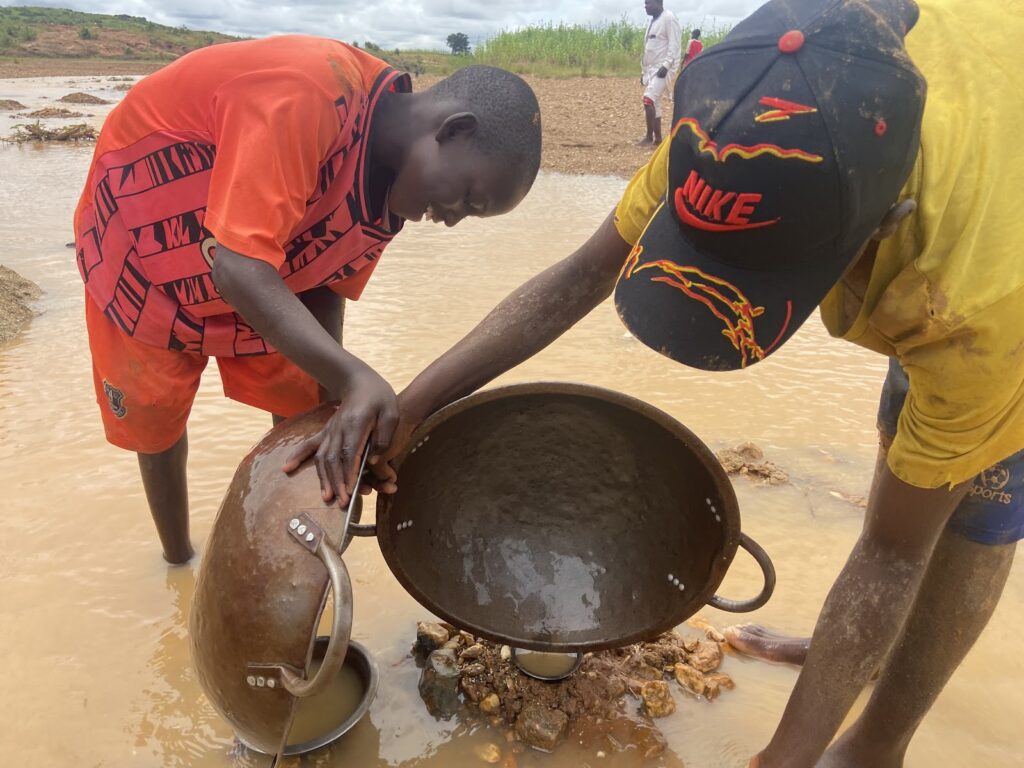
Since 2011, when the armed conflict escalated, Nigeria’s northwestern region has remained a hotspot for terrorists. They prey on rural communities, emptying villages and driving farmers from their farms. The more than 30,000-member gangs also controlled a large kidnap-for-ransom industry that has disrupted the economy of the predominantly farming communities and impoverished families across the region.
The region is home to some 45 million people below the poverty line. Artisanal mining — often illegal and typically involves manual labour — has become a source of income for many in most mineral-rich areas in the region. Across many of these illegal mining sites, child labour is common. A recent report by the country’s statistics agency, NBS, shows that four out of every ten children in the country are trapped in child labour.
To put this into perspective, it means about 24,673,485, representing 39.2 per cent of Nigerian children aged five to seventeen, are engaged in child labour, with more than 14 million involved in hazardous works like mining. Children like Salisu fall within this group, representing 22.9 per cent. Their works essentially spoon-feed the country’s artisanal and small-scale mining industry, accounting for about 80 per cent of the country’s mining operations. There are more than 1,759 illegal mining sites spread across different parts of the country, costing about $9 billion annually.
In 2019, the Nigerian government suspended mining in Zamfara amid concerns that it was connected to the uptick in the violence ravaging the region. Successive authorities in the state have also taken similar measures. Last year, the state governor, Dauda Lawal, issued a shoot-on-sight directive on illegal miners. The directive has yielded few results as children like Salisu fill the gap created by miners who relocated from Zamfara to other areas.
Salisu wears adulthood like borrowed clothes. He’s vocal and exuberant. When he speaks, his fellows at the site lean in to catch a glimpse of him, at his tactfulness and concise use of words. And when they splash water at one another, playing in the flowing river, he jumps in excitement like the child that he truly is.
“I want to support both my parents and relatives,” he said, stroking his furrowed brow before cracking a smile that broke the solemn facade. “What I fear most is not being able to achieve my goal to have a farm of my own. I have seen one of my fellows die when the shafts collapsed on him. It’s sad. May God help and give us what will benefit us.”
Evidence shows that children like him wouldn’t have become adults too early if the state’s child protection laws had been enforced at all. The Child Rights Act, signed into law about 21 years ago, holds promises for Nigerian children. First, it seeks to protect them against abuses and safeguard their rights, especially regarding education. Secondly, it frowns on the use of children as labourers, particularly in backbreaking activities like mining.
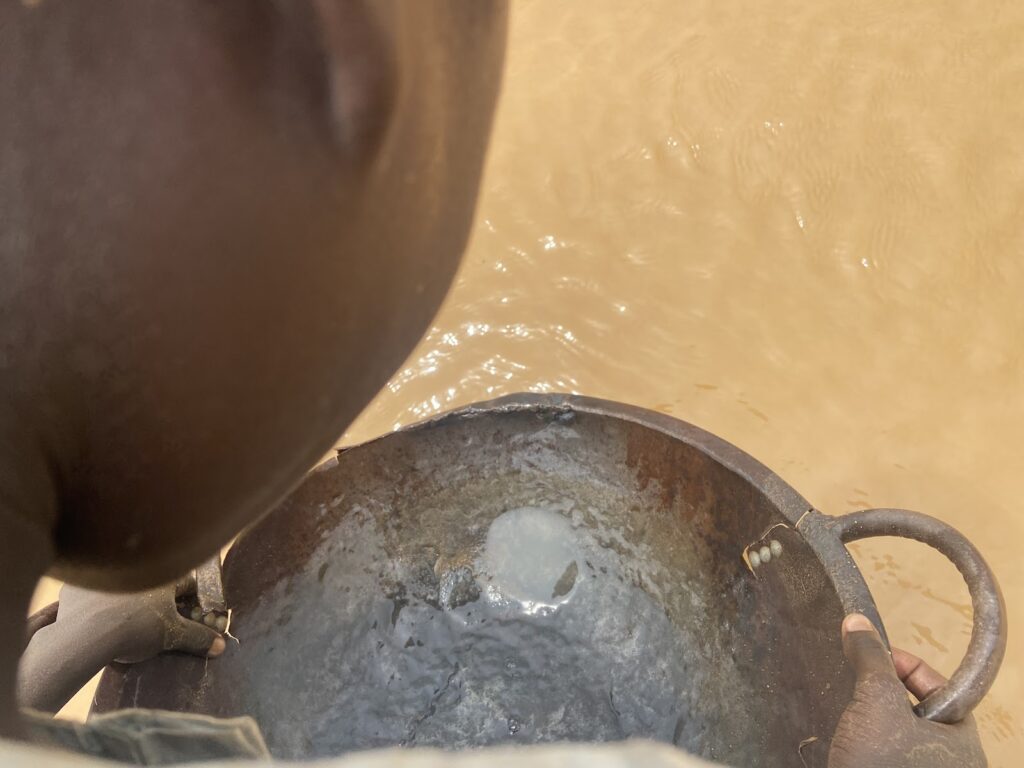
However, the application of the law is subject to its domestication by state governments. Zamfara signed the act into law two years ago but only recently worked on its implementation strategy. In May, the state authorities announced that the plan to implement the law was in the pipeline. Currently, children in the state do not have a working strategy to enforce their rights. This is further complicated by the obsolete provisions of the country’s labour laws. Concerning child labour, the law doesn’t cover children who are self-employed or working in the informal sector, like artisanal gold mining.
The state’s Commissioner for Women and Children Affairs, Nafisa Maradun, could not be reached for comments. It was later learnt that an order barred government appointees and civil servants in the state from granting media interviews.
Agatha Kolawole, the Project Coordinator on child labour at the International Labour Organisation, told HumAngle there has been a spike in the rates at which children are engaged in physical labour that are not only hazardous but also impede their rights to education.
“For the first time in several years, the prevalence of child labour has increased as children are now more at greater risks of facing circumstances that are even more difficult and working longer hours to survive,” Agatha said. “Poverty is the major force driving the use of child labour in the agricultural and mines sectors; due to the level of poverty, and for the family households to be able to get them sustained, children are drafted into the labour market.”
A child like an adult
For Aliyu Ibrahim, 11, the path to becoming a child miner began with watching his two brothers leave home early in the morning to search for their fortunes. Two years ago, he started trailing behind them to the illegal gold mining site on the outskirts of their village, where dozens of makeshift pits and tunnels scar the rust-coloured earth. At first, his legs struggled to keep pace as they navigated the jagged terrain. Sometimes, he strained his legs before he began to hold the shovel.
Ibrahim is unusually small but agile. His hands, calloused beyond his years, grip the worn wooden handle of his shovel. The tool is nearly as tall as he is, but he wields it with some uncommon passion, cutting through the soil alongside men two times his age. His days begin at dawn with the muezzin’s melodic call to prayer reverberating through the village. Ibrahim rises from his thin mattress shared with two other siblings, performs his ablution and prays, after which he returns to the house and curls up for a quick nap until the morning breaks.
Like other kids his age at the mining site, Ibrahim’s education ended with primary school. When asked why he was not in school, he glances at the shaft where his brothers work, then down at his dust-covered feet.
“I come here to help my parents,” he said. “When there’s no food at home, you don’t think about school.”
Even if he wanted to, there are not enough schools for kids like him. They’re either under lock or deserted, especially since terrorists turn their gaze towards school children in rural and underserved villages for huge ransom.
Around him, the mining site keeps buzzing with activities — the clangs of tools, the murmur of workers and the occasional screams of triumph when someone spots a promising glint in their pan. Ibrahim kept digging the muddy field, sifting through reddish soil for his fortunes, “I’ve been doing this for about two years now,” he continued. “When I sell the gold, it can be like 5,000 to 10,000 naira. I can save up to 10,000 naira in a week.”
It may sound like a meagre amount, but it helps to sustain his family. Rather than keeping his earnings for himself, Ibrahim gives the bulk of the money to his parents. “On days when I don’t find anything, I have nothing.” He said his parents hold onto the savings for him, helping to ensure the money is not squandered.
Ibrahim sieved the glint of gold he found into a clean bowl and headed back to the pit. But before he bent to hew the soil with his shovel, he sat on the edge of the mine and wiped the beads of sweat forming on his forehead. He picked himself up, swung the shovel in the air, and then deep into the muddy earth.
“I want to continue my education,” he said softly. “My parents are working hard to make that happen. This work… it can wait. School comes first.”
His dream, however, lies heavily in the hands of his parents. Some parents are not worried that their children are not in school as long as the kids return home safely under the dark of the evening’s overwhelming clouds, exhausted but with enough money to keep the family afloat.
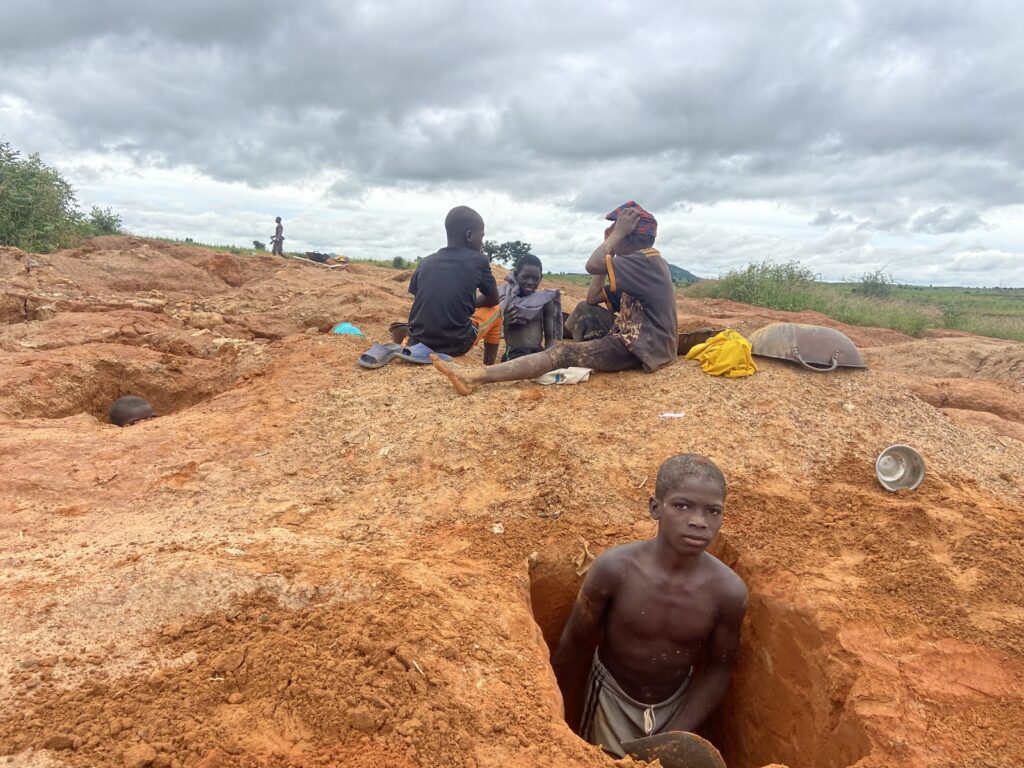
Eating from the proceeds of child labour
Rabi’u Bawa, 57, walked towards the wood pile at a sawmill on the highway. It’s a regular evening gathering spot called “majalisa,” where men his age come together to crack jokes and discuss their community’s issues. Three of Bawa’s sons are involved in mining: Salisu, the eldest at 21; Abba, who recently turned 18; and Umaru, the youngest, at just 14 years old.
Like many others in the village, Bawa is an enterprising farmer, but he is also a local vigilante — two jobs that constantly slap a target on his back. Terrorists go after farmers for levies and, without payment, are often denied access to their farms. Between 2020 and 2023, farmers in the region paid at least ₦139.5 million to terrorists as levies, according to reports.
As a vigilante, he goes after the gangs, protecting the community against the tide of the violence that has come to plague the areas. But this comes at a cost – the threat of reprisals means he can no longer safely tend to his farms. Recently, this has strained his ability to take care of his family — something his sons, with their mining earnings, have stepped in to help fill the gaps.
“There’s a day I spent the whole day without a penny in my pocket,” Bawa recalled. “Luckily, they came back with money that day, and each gave me ten thousand naira.”
“By going to the mine to dig for gold, they’re not only helping themselves, they help us too. Honestly, I feel good about this because a child who works won’t become useless. When a child has nothing to do, he might go to dangerous places, get into trouble, or even become a terrorist,” he added, noting that a child with income doesn’t need to be fed because “he can take care of himself”.
But human rights organisations like Amnesty International would disagree. The engagement of children in physically straining activities like mining violates provisions of relevant extant laws outlawing child labour.
“Child labour is unlawful — no matter the circumstances. It is exploitative and takes advantage of children who do not have the ability to make decisions of their own,” Isa Sanusi, the Country Director at Amnesty International, told HumAngle. “While the Child Rights Act has provisions protecting children from such exploitation, the failure of authorities to hold parents and employers to account is further endangering the lives of children and poses the risk of creating a lost generation that will grow with the scars of exploitation. No family should be allowed to use its children as means of earning livelihood.”
Asked if he’s aware allowing children to work in backbreaking activities like mining violates the law, Bawa retorted, saying: “I know about the law that restricts child labour because it seems like slavery, but due to lack of good governance and the current situation in the country, we can’t take responsibility for everything children need – school fees, food, clothing, and shelter. They have to work, too. We must work together to sort things out.”
A thief at night
Like a thief stealing the night’s glimmer, the children face the shadow of long-term health risks, including potential spinal injuries from years of carrying heavy loads. At the moment, many of the child miners who spoke with HumAngle across sites in Maru said they sometimes suffer neck or back pains. To cope, they resort to self-medicating with over-the-counter painkillers like Diclofenac and paracetamol, masking the pain while the underlying damage remains untreated.
“When I take them [the painkillers], I don’t feel pain,” Salisu said. “There are always jobs that require energy. Maybe when there is work waiting for us at home, like going to the farm or anything like that, I just take them.”
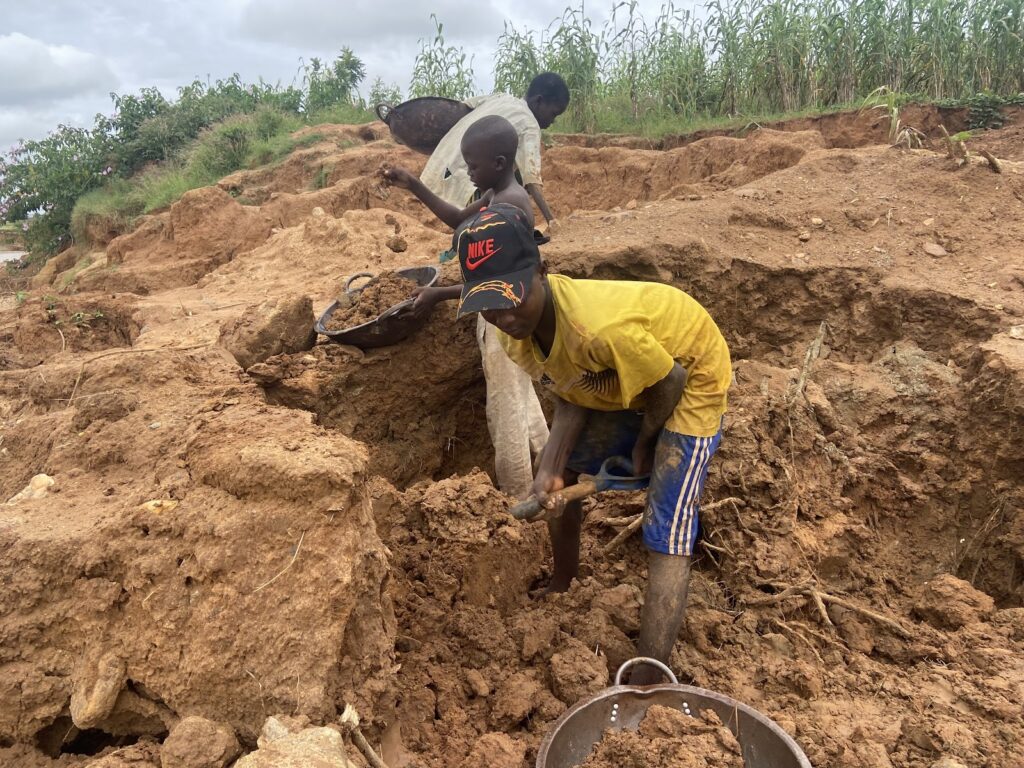
HumAngle observed that the children worked long hours without basic protective equipment such as gloves, work clothes or facemasks to protect them from the smothering dust in the mines. In 2010, more than 400 children died as a result of lead poisoning through unsafe, artisanal mining activities in part of Anka and Bukuyyum areas in the state.
At the mining site in Maru, Ibrahim Sanusi sat on the entrance of a mine shaft, dangling his two legs into darkness as he prepared to go underground. The shaft’s rectangular opening gaped before him — three feet wide — lacking timber or metal supports. Like many illegal mining sites, this one was crude, with rough-hewn holes carved into the walls for climbing. Sanusi studied the descent path carefully. Five years of illegal mining has taught him to read the ground’s mood.

The 17-year-old adjusted the small torch strapped to his forehead and checked his bottled water one last time before sticking his feet into one of the holes and then the other for balance. About thirty metres down, the shaft would narrow, and the air grew thicker. His hair wore residue of the hovering dust.
“This work comes with its own problems,” he said. “It’s always a matter of life or death; we can die at any time. The mine could collapse and fall and bury us alive.
On average, across the illegal mining sites we visited, the children work approximately eight hours per day, fifty-six hours a week. They get to the mine early, a little before 10 a.m. or after. Many say they close for the day when it’s time for evening prayer.
HumAngle shared their situation with a public health specialist, Tanimola Akande, a professor at the University of Ilorin in Kwara. Akande mentioned that the physical health implications of their activities in the mines may include chronic osteoarthritis of the vertebrae due to the posture they maintain while working.
“This has long-term consequences leading to chronic back pain and vertebrae deformities and may also cause compression on the spinal cord. They usually also suffer from burnout and a lot of stress. Because of the nature of the work, they often use energy-enhancing drugs and strong analgesics that are addictive and very likely to affect their mental health. We’re dealing with a potential health crisis,” he added.
But none of this would discourage the children. Their penury leaves many of them with fewer choices. “I know it’s dangerous, but it’s something we have to do if we’re ever going to feed ourselves and our parents,” Sanusi said.
The vicious cycle
Who profits off the sweat of these children? Where does the gold they mined end up? Sources told HumAngle that the supply chain is a complex web, starting with the miners and local traders, followed by secondary intermediaries who sell to major players in Gusau, the state capital. From there, the gold is smuggled across Nigeria’s porous borders to destinations like Niger, Togo, or the United Arab Emirates (UAE).
The child miners sell their gold to local traders within the mining communities, typically in small units measured in decigrams. These traders accumulate as much as 50 to 100 grams of gold before selling it wholesale to secondary traders. Local buyers are often self-financed, particularly when working as lone wolves. They melt the gold, losing some parts as impurities to get batches of tens of grams, which will fetch the trader a higher price when sold.

When the local buyers work for the secondary trader, they often visit mining sites to buy available collected gold in exchange for a percentage commission from the secondary trader, who also provides advance capital needed to buy the gold. After collection across the mining sites in the area, generally hundreds of grams, the secondary trader will travel down and gather the accumulated gold before travelling to Gusau, where it’s traded with the big players who buy the gold and subsequently smuggle them out of the country as foreign demands for the precious metal surge. As of November, a kilogram of gold is priced at $85,790 in the global market.
Each year, between 321 and 474 tonnes of gold produced through artisanal and small-scale mining, where most underage miners work, are not declared for export in most African countries. This represents a market value of about $23.7 billion and $35 billion annually. Most of the gold is shipped to countries like India, Switzerland, and the United Arab Emirates.
In eighteen conflict-affected zones, including Nigeria, the Middle Eastern country is the leading destination for the artisanal gold mined in these countries. Some of the gold is transported directly to Dubai, while some first transit through a neighbouring country. In the case of Nigeria, most of the time, it goes through the Republic of Niger. For instance, in 2022, about 317 tonnes of gold was smuggled out of these countries to Dubai.
Proceeds from the smuggling return to these countries to finance terror groups and their activities. Using forced and paid labour involving children, the late terror kingpin Halilu Sububu controlled several illegal mining sites in the Bagega area of Anka. By late 2023, Sububu had become the largest armed supplier to other regional terror kingpins. This is not unconnected to his mining activities, kidnappings, arms smuggling and levies he collected from local communities. Following his death at the hands of the Nigerian Military, his successor, Najaja, is overseeing the illegal gold mining operations in the area.
“The proceeds from illegally-mined gold largely contribute to sustaining the operations of bandits in the region, including recruitment and logistics like weapons,” says Samuel Malik, a senior researcher at the Pan-African think tank Good Governance Africa. Samuel is currently researching the direct link between illegal gold mining and the sprawling violence in the region. “Bandit leaders controlling mining sites smuggle the mined gold outside Nigeria. In return, they bring in weapons to Nigeria. Halilu used to smuggle gold from the country to the Sahel and brought back weapons. His successor has now taken over the mining operations. And it’s expected that he will try to continue in Halilu’s shoes because he used to follow him on the smuggling activities.”
Children like Salisu and Sanusi are unaware that their work in the mining sites may come back to haunt them and their communities. It’s likely the arms bought with the gold money that killed and displaced their neighbours, and most likely, it’s why they end up taking up responsibilities they are not prepared for. What matters, for many, is that they can step out every morning to dig for gold and take it to the local buyers for money.
